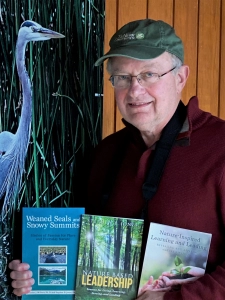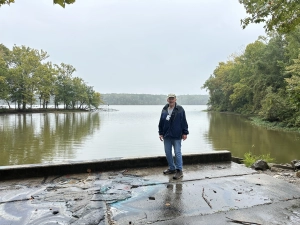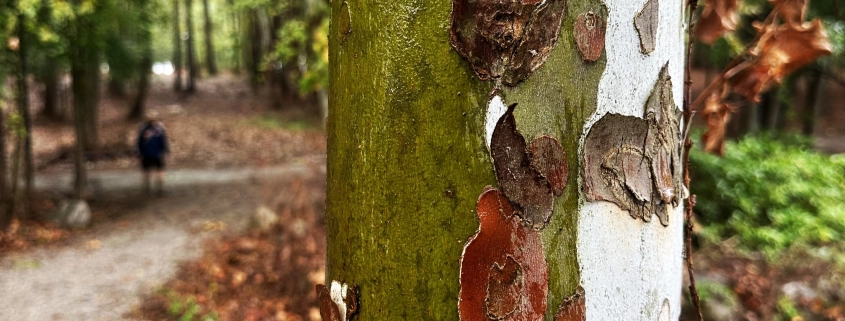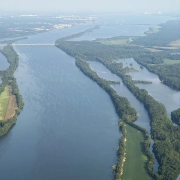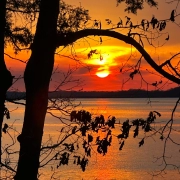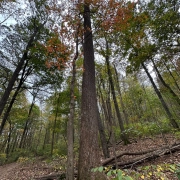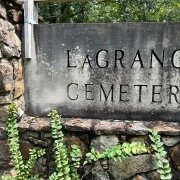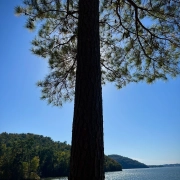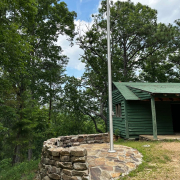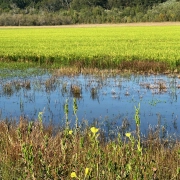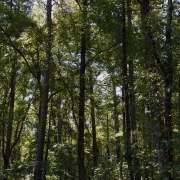Exploring the Forest along Lake Wheeler at Point Mallard Park!
On September 29, 2024, I co-led a University of Alabama in Huntsville OLLI (Osher Lifelong Learning Institute) Nature Walk at Point Mallard Park in nearby Decatur, Alabama. We departed a picnic shelter at 3:00 PM as a shower associated with superstorm Helene was abating.
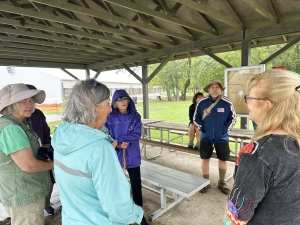
The Park borders Dinsmore Slough and Flint Creek on the west extension of the Wheeler National Wildlife Refuge, on the south side of the Refuge. The Tennessee River (Wheeler Lake) and the Refuge reach some 20 miles upstream to Ditto Landing, on the north side of the river southeast of Huntsville. I view the Refuge as one of my go-to places for Nature wandering. The view below to the east and southeast looks exclusively over the west end of the Refuge.
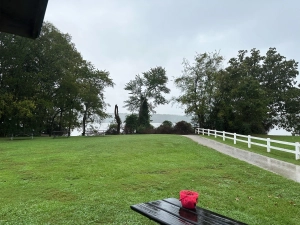
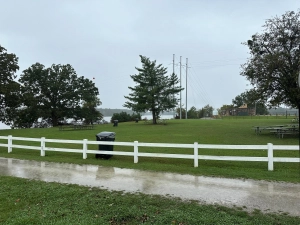
Randy and Kim’s hat and umbrella evidence that the rain had not yet ceased as they provided foreground to the expansive lake and Refuge forest edge at the far shore.
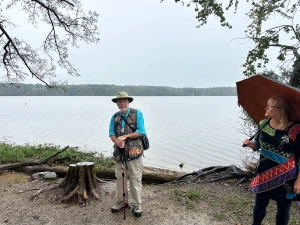
Nature alone provides amusement and sparks curiosity and imagination. Over the past 13 millennia, since Native Americans first populated this region, the Tennesee River provided food, transportation, and sites for gathering and habitation. Humans have left the mark of their occupation in countless ways across those 130 centuries. I wonder how many Native men, women, and children leaned a stone against a young sycamore tree, and then witnessed the tree slowly grow around it, a seeming act of consumption. Maybe none. However, one of our recent inhabitants propped a five-foot slab of cement against this sycamore 10-20 years ago. Darrell and Kim stood near it for scale. Certainly the effect is amusing, curious, and sparks immagination…but the result is not Nature acting alone.
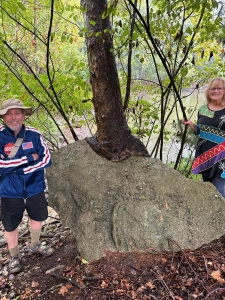
Rain pften enriches my forest wanderings, even as it dampens the way and soaks my garb. Since retiring to northern Alabama, I’ve grown fond of the perrenial green and smooth bark of supplejack vine. I don’t recall ever seeing the wetted vine showing prominent white vertical striations. I’ll henceforth pay more attention. This may turn out to be a unique individual or perhaps this is a common feature hidden in plain sight without the accent provided by the earlier shower.
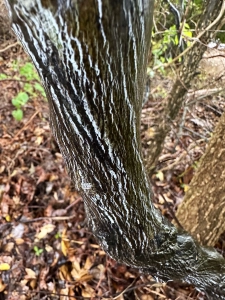
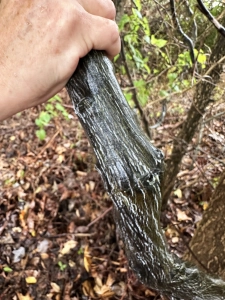
The eight-inch diameter sycamore below left likewise drew my attention…and camera lens. The half-green and white trunk punctuated with brown flecks would, without the recent wetting, have been nothing special. I hadn’t noticed one of our OLLI group walking along the trail in the distance until I examined the photo. The background elements enhance the image of the tree.
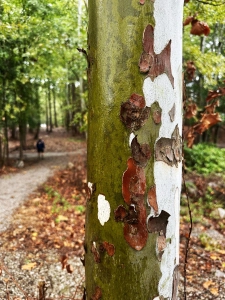
The nearby 10-inch-diameter sycamore, backdropped by the slough, does not project the same attractive bark countenance.
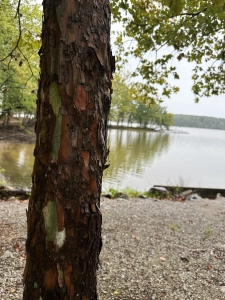
Always on the lookout for tree form curiosities and oddities, I found intrigue and mystery in water oak. The bloated, convoluted form signals internal decay…or alternatively viral and or bacterial infection emanatring from an old wound. In reality, I can’t say for certain. The tree is grossly mishapen due to some combination of physical and biological factors. The tree may be hollow…or it may have exotic wood grain within. Were I a bowl-turner of wood craftsman, I might have greater interest in what lay hidden beneath the bark.
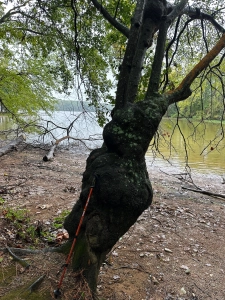
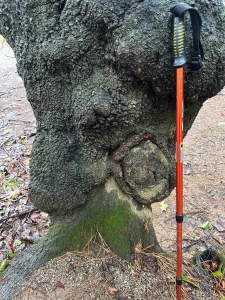
Here is my 51-second video of the contorted water oak:
Although we classifed our OLLI outing as as a Nature Walk, the group soon advance beyond me in the damp afternoon. I was content to proceed at a Nature Walk pace, seeking novelties hidden in pain sight.
Woodland Fungi
Numerous and varied mushrooms attracted my attention. Oysters, one of my favorite edibles, grew on a downed trunk just off the trail. I harvested a cluster, with a primary purpose of showing the group far ahead what they had missed as they commited the unpardonable sin of walking through the forest rather that sauntering within the forest. I admit to a secondary purpose — making sure that I protected enough of the cluster to saute with tomorrow morning’s eggs!
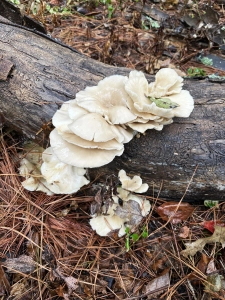
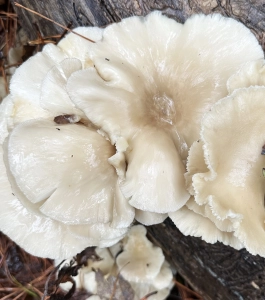
Not nearly as large and conspicuous, trooping crumble cap mushrooms appeared to live uo to their name, marching across the sodden litter.
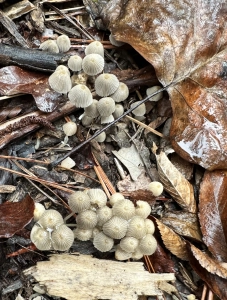
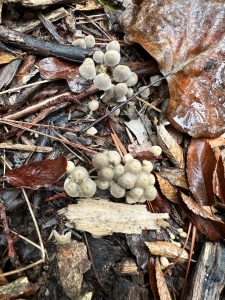
I failed capture a decent photo of the large colony of amber jelly mushrooms we encountered after we connected with the full OLLI group as we returned to the parking lot. All local jelly mushrooms are edible. I the interest of Nature education and interpretation, I collected a handful of the jellies. These were among the largest individuals I have found. Were I foraging on a property where I had permission to harvest, I could have collected a bucketful of both amber jelly and oysters. Here are my educational samples cleaned and ready for simmering, should my interpretive purposes be fulfilled!
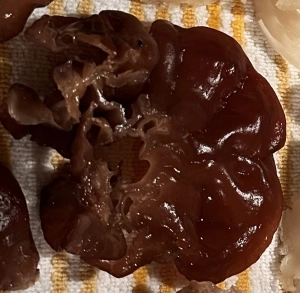
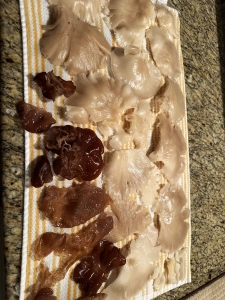
Only during retirement have I begun my pursuit of edible mushrooms, beginning with oysters and evolving through a currect set of nearly one dozen species more or less common in northern Alabama. Lion’s mane is my favorite; I don’t find it as often as I would like. I love morrels, but I am afriad that we lie south of their preferred range. I even like the common puffballs and meadow mushrooms that I find in neighborhood lawns and athletic fields. I hold fast to several foraging rules I have adopted:
- Eat only those species for which my certainty is 100 percent
- Never consume an uncooked mushroom
- Clean harvested mushrooms to remove most of the associated insect and slug protein
- Urge potential foragers to do extensive homework — don’t take my word for anything
- Don’t chew off more than you can bite — a twist on the more common advice to not bite off more than you can chew
The process of foraging, cleaning, cooking, and packaging is time consuming. At the completion of this chanterelle foraging venture three years ago, I felt like I had chewed off more than I could bite!
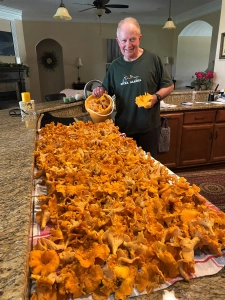
Mushroom foraging is an active hobby, and a great way to learn about new facets of the forest ecosystem. Both oysters and jellies are the reproductive organs (spore-producing), chanterelles are associated with myc0rhizal fungi which form essential symbiotic relationships with tree roots.
Clearing Sky
We’ve watched the news of Helene’s devastation from Category Four impact at Florida’s Big Bend to its record-setting rainfall and flooding through Georgia, the Carolnas, Virginia, and Tennessee. Much of the most flood-ravaged region lies within the upper Tennessee River Basin. Almost without exception, the storm delivered from five to 30+ inches upstream from Chattanooga, including the French Broad Basin and Asheville. I measured just 1.51 inches in my Madison, Alabama backyard gauge. We were fortunate to be far west of the track. The clearing sky at Point Mallard revealed no damage…only the damp beauty of parting clouds.
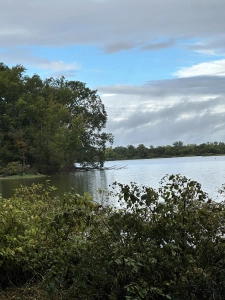
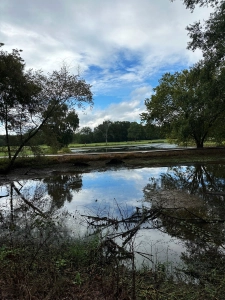
I recorded this 46-second video of promising evening freshened by the departing showers.
I great egret likewise welcomed the drying weather. With the slough behind me, the egret stands in a wetland pondadjacent to the Park golf course. Egrets and herons elevate the esthetic value of such recreational venues, and amplify the ecosystem integrity and ecological complexity of revirside Park.
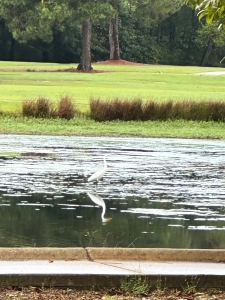
I felt blessed just five weeks after total right knee replacement surgery to return to Nature’s glory on such a placid evening on gentle trails. I’m rekindld, rejevenated, and grateful!
Thoughts and Reflections
I offer these observations:
- Gloomy skies and rainy days can lift routine Nature to a level of exceptional beauty.
- Nature’s ferocity (i.e. Helene in the southern Appalachians) often displays a softer side, in this case, three days of gentle showers in the Huntsville area.
- When we contemplate the whole globe as one great dewdrop, striped and dotted with continents and islands, flying through space with other stars all singing and shining together as one, the whole universe appears as an infinite storm of beauty. (John Muir)
Inhale and absorb Nature’s elixir. May Nature Inspire, Inform, and Reward you!
Note: Unless otherwise noted, all blog post images are created & photographeerved.”
And Third: I am availabd by Stephen B. Jones. Please circulate images with photo credit: “©2024 Steve Jones, Great Blue Heron LLC. All Rights Resle for Nature-Inspired Speaking, Writing, and Consulting — contact me at steve.jones.0524@gmail.com
A reminder of my Personal and Professional Purpose, Passion, and Cause
If only more of us viewed our precious environment through the filters I employ. If only my mission and vision could be multiplied by untold orders of magnitude:
Mission: Employ writing and speaking to educate, inspire, and enable readers and listeners to understand, appreciate, and enjoy Nature… and accept and practice Earth Stewardship.
Vision:
- People of all ages will pay greater attention to and engage more regularly with Nature… and will accept and practice informed and responsible Earth Stewardship.
- They will see their relationship to our natural world with new eyes… and understand their Earth home more clearly.
Tagline/Motto: Steve (Great Blue Heron) encourages and seeks a better tomorrow through Nature-Inspired Living!
Steve’s Four Books
I wrote my books Nature Based Leadership (2016), Nature-Inspired Learning and Leading (2017), Weaned Seals and Snowy Summits: Stories of Passion for Place and Everyday Nature (2019; co-authored with Dr. Jennifer Wilhoit), and Dutton Land & Cattle: A Land Legacy Story (2023) to encourage all citizens to recognize and appreciate that every lesson for living, learning, serving, and leading is either written indelibly in or is powerfully inspired by Nature. All four of my books present compilations of personal experiences expressing my deep passion for Nature. All four books offer observations and reflections on my relationship with the natural world… and the broader implications for society. Order any from your local indie bookstore, or find them on IndieBound or other online sources such as Amazon and LifeRich.
I began writing books and Posts for several reasons:
- I love hiking and exploring Nature
- I see images I want to (and do) capture with my trusty iPhone camera
- I enjoy explaining those images — an educator at heart
- I don’t play golf!
- I do love writing — it’s the hobby I never needed when my career consumed me
- Judy suggested my writing is in large measure my legacy to our two kids, our five grandkids, and all the unborn generations beyond
- And finally, perhaps my books and Blogs could reach beyond family and touch a few other lives… sow some seeds for the future
